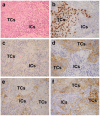Low PD-L1 Expression Strongly Correlates with Local Recurrence in Epstein-Barr Virus-Positive Nasopharyngeal Carcinoma after Radiation-Based Therapy
- PMID: 30304846
- PMCID: PMC6211078
- DOI: 10.3390/cancers10100374
Low PD-L1 Expression Strongly Correlates with Local Recurrence in Epstein-Barr Virus-Positive Nasopharyngeal Carcinoma after Radiation-Based Therapy
Abstract
The prognostic value of programmed death-ligand 1 (PD-L1) expression in nasopharyngeal carcinoma (NPC) is controversial, with previous studies showing conflicting results. Most NPCs in endemic areas are Epstein-Barr virus (EBV)-positive. Our aim was to evaluate the clinical significance of PD-L1 expression in EBV-positive NPC. We retrospectively analyzed PD-L1 expression on tumor cells (TCs) and immune cells (ICs) by immunohistochemistry in 208 EBV-positive NPC patients who underwent radiotherapy (203 with concurrent chemotherapy). The percentages of TCs and ICs expressing PD-L1 were evaluated respectively. There was a strong correlation between local recurrence and low PD-L1 expression on ICs (p = 0.0012), TCs (p = 0.013) or both (p = 0.000044), whereas all clinical parameters had no influence on local recurrence. Using multivariate analysis, low PD-L1 expression on ICs was an independent adverse prognostic factor (p = 0.0080; HR = 1.88; 95% CI = 1.18⁻3.00) for disease-free survival. High PD-L1 expression on both ICs and TCs was an independent favorable prognostic factor (p = 0.022; HR = 0.46; 95% CI = 0.24⁻0.89) for overall survival. We show for the first time that low PD-L1 expression on ICs and TCs strongly correlates with local recurrence in EBV-positive NPC patients after radiation-based therapy. A simple immunohistochemical study for PD-L1 can identify patients prone to local recurrence, and such patients might benefit from more aggressive treatment in future clinical trials.
Keywords: Epstein-Barr virus; immunohistochemistry; local recurrence; nasopharyngeal carcinoma; programmed death-ligand 1; radiotherapy; survival.
Conflict of interest statement
The authors declare no conflict of interest.
Figures






Similar articles
-
Prognostic Value of Programmed Cell Death Ligand-1 Expression in Nasopharyngeal Carcinoma: A Meta-Analysis of 1,315 Patients.Front Oncol. 2019 Oct 25;9:1111. doi: 10.3389/fonc.2019.01111. eCollection 2019. Front Oncol. 2019. PMID: 31709181 Free PMC article.
-
Characterization of PD-L1 and PD-1 Expression and CD8+ Tumor-infiltrating Lymphocyte in Epstein-Barr Virus-associated Nasopharyngeal Carcinoma.Am J Clin Oncol. 2018 Dec;41(12):1204-1210. doi: 10.1097/COC.0000000000000449. Am J Clin Oncol. 2018. PMID: 29672367
-
Programmed Death-Ligand 1 Expression, Microsatellite Instability, Epstein-Barr Virus, and Human Papillomavirus in Nasopharyngeal Carcinomas of Patients from the Philippines.Head Neck Pathol. 2017 Jun;11(2):203-211. doi: 10.1007/s12105-016-0765-y. Epub 2016 Nov 2. Head Neck Pathol. 2017. PMID: 27807760 Free PMC article.
-
Clinicopathological features of programmed death ligand 1 expression with tumor-infiltrating lymphocyte, mismatch repair, and Epstein-Barr virus status in a large cohort of gastric cancer patients.Gastric Cancer. 2017 May;20(3):407-415. doi: 10.1007/s10120-016-0631-3. Epub 2016 Sep 14. Gastric Cancer. 2017. PMID: 27629881
-
Targeting the PD-1/ PD-L1 interaction in nasopharyngeal carcinoma.Oral Oncol. 2021 Feb;113:105127. doi: 10.1016/j.oraloncology.2020.105127. Epub 2021 Jan 14. Oral Oncol. 2021. PMID: 33454551 Review.
Cited by
-
The prognostic significance of PD-L1 and PD-1 expression in patients with nasopharyngeal carcinoma: a systematic review and meta-analysis.Cancer Cell Int. 2019 May 22;19:141. doi: 10.1186/s12935-019-0863-5. eCollection 2019. Cancer Cell Int. 2019. PMID: 31139018 Free PMC article.
-
Expression and clinical significance of PD-L1 and BRAF expression in nasopharyngeal carcinoma.BMC Cancer. 2019 Oct 29;19(1):1022. doi: 10.1186/s12885-019-6276-y. BMC Cancer. 2019. PMID: 31664962 Free PMC article.
-
Prognostic Value of Programmed Cell Death Ligand-1 Expression in Nasopharyngeal Carcinoma: A Meta-Analysis of 1,315 Patients.Front Oncol. 2019 Oct 25;9:1111. doi: 10.3389/fonc.2019.01111. eCollection 2019. Front Oncol. 2019. PMID: 31709181 Free PMC article.
-
Expression and Prognostic Significance of PD-L2 in Diffuse Large B-Cell Lymphoma.Front Oncol. 2021 Jun 10;11:664032. doi: 10.3389/fonc.2021.664032. eCollection 2021. Front Oncol. 2021. PMID: 34178648 Free PMC article.
-
The clinical prognostic value of PD-L1 after concurrent chemoradiotherapy in Chinese nasopharyngeal carcinoma patients.Ann Transl Med. 2021 Nov;9(22):1650. doi: 10.21037/atm-21-5175. Ann Transl Med. 2021. PMID: 34988159 Free PMC article.
References
-
- Petersson B.F., Bell D., El-Mofty S.K., Gillison M., Lewis J.S., Nadal A., Nicolai P., Wenig B.M. Nasopharyngeal carcinoma. In: El-Naggar A.K., Chan J.K.C., Grandis J.R., Takata T., Slootweg P.J., editors. WHO Classification of Head and Neck Tumours. 4th ed. IARC; Lyon, France: 2017. pp. 65–70.
Grants and funding
LinkOut - more resources
Full Text Sources
Research Materials

